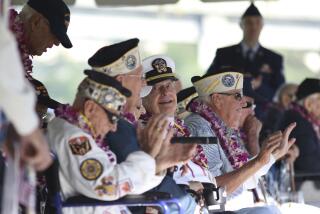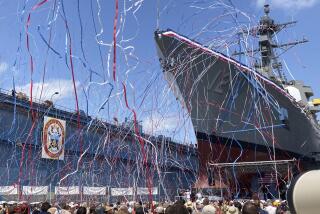Adm. Arleigh A. Burke; War Hero, Leading Architect of Modern Navy
- Share via
WASHINGTON — Adm. Arleigh A. Burke, one of the great fighting sailors of World War II who as chief of naval operations became a leading architect of the postwar Navy and became one of his service’s most revered figures, died of pneumonia Monday at Bethesda Naval Hospital. He was 94.
He gained fame in World War II as the tactical commander of Destroyer Squadron 23 in the Pacific. His flamboyant and brilliant tactics included leading his squadron into battle at “maximum speed” and gained him the nickname “31-Knot Burke.” After the war, he became the only person to serve three terms as chief of naval operations--a post he held from 1955 until retiring from active duty in 1961.
As chief of naval operations, he led the Navy into the age of jet aircraft, guided missiles and nuclear submarines. He ordered the development and deployment of the Polaris system, among the first submarines armed with nuclear ballistic missiles. He also ensured that the Navy was equipped to fight peripheral wars with conventional weapons, a part of defense doctrine even today.
Upon retiring from active duty, Burke helped found the Center for Strategic and International Studies at Georgetown University, an influential foreign-and defense-policy think tank. He served as the center’s director for 15 years.
The admiral once said: “I don’t think it’s very important that I be remembered. . . . The ideas I stood for should be remembered.” Others disagreed with part of that statement.
“We will remember him as one of America’s finest sailors and most capable military leaders,” President Clinton said in a statement issued at Hilton Head, S.C., where he was attending a New Year weekend gathering.
The current chief of naval operations, Adm. Mike Boorda, said, “Adm. Arleigh Burke defined what it means to be a naval officer: relentless in combat, resourceful in command and revered by his crews. He was a sailor’s sailor.”
Navy Secretary John H. Dalton said that Burke would be remembered as “the very embodiment of honor, courage, and commitment” and that “the nation has lost a true hero.”
One measure of the Navy’s and the nation’s regard for the dashing World War II destroyer leader came when the service named an entire new class of destroyers, the most powerful ever built, the Arleigh Burke class. There also is an Arleigh A. Burke Hall at the Naval War College in Newport, R.I., and an annual Arleigh A. Burke Competition for the best essay on leadership, for which the U.S. Naval Institute offers a $1,000 prize.
In 1991, when an Arleigh Burke class ship named after him was commissioned, the old admiral was there. Perhaps characteristically, he coupled praise and admiration for the ship with a crusty challenge to its first crew: “This ship is built to fight. You’d better know how.”
Burke’s decorations included the Navy Cross, the highest decoration for heroism except for the Medal of Honor, three Distinguished Service medals, the Silver Star, three Legions of Merit and the Purple Heart.
Though funeral arrangements are incomplete, Burke’s funeral is likely to be the nation’s largest and most impressive military funeral in at least 30 years, with more than 2,500 dignitaries and other mourners expected. He will lie in state Thursday morning in the Naval Academy Chapel in Annapolis before services there at 11 a.m. The military ceremonies will include two 19-gun salutes and a jet flyover during the interment at the academy cemetery, and the entire crew of the Arleigh Burke will line the streets along the way.
He will be buried beneath a 4 1/2-foot black granite monument that, at his instruction, bears only four stars, an etching of the ship named after him and the words “Adm. Arleigh A. Burke, Sailor.”
Burke, cheerful and plain-spoken, used to say his success was the result of hard work and luck rather than native talent or intellect. In fact he had several assignments that were nothing if not intellectually demanding, and he guided a number of influential studies on strategy and the role of the Navy. He also was extremely skillful in the politics of national security at the highest level.
He was attracted to the Navy because it was a place where, in his words, the rules were “strict, known and observed.” He also believed that all military men share ideals of bravery and sacrifice. Thus, in the midst of the war, he honored a Japanese captain who had fought bravely against overwhelming odds and gone down with his ship.
Burke married the former Roberta Gorsuch of Washington on the afternoon of the day he graduated from the Naval Academy in 1923. They had no children.
More to Read
Sign up for Essential California
The most important California stories and recommendations in your inbox every morning.
You may occasionally receive promotional content from the Los Angeles Times.













